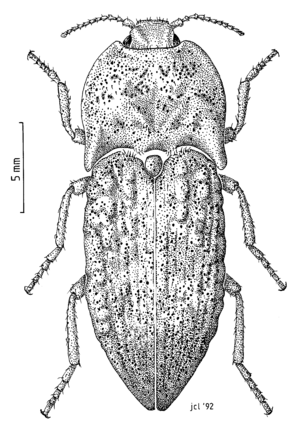Cook Strait click beetle facts for kids
Quick facts for kids Cook Strait click beetle |
|
|---|---|
 |
|
| Amychus granulatus by Joanna Liddiard | |
| Conservation status | |
|
Invalid status (NZ TCS)
|
|
| Scientific classification | |
| Genus: |
Amychus
|
| Species: |
granulatus
|
| Synonyms | |
|
|
The Amychus granulatus, often called the Cook Strait click beetle, is a large beetle that cannot fly. It is part of the Elateridae family. These beetles are usually known for their ability to make a clicking sound and jump when they are on their backs. However, the Cook Strait click beetle cannot do this.
Contents
What Does the Cook Strait Click Beetle Look Like?
Adult Cook Strait click beetles are easy to tell apart from other similar beetles. They have a wide, flat body and small, round bumps on their wing covers. These beetles are quite big, usually between 16 and 22.5 millimeters long. They have tiny, unused wings, which is why they cannot fly.
Where Does the Cook Strait Click Beetle Live?

This special beetle was first found by a lighthouse keeper named Andreas Sandager. He discovered it on North Brother Island in Cook Strait in 1881. Today, you can only find the Cook Strait click beetle on islands in the outer Marlborough Sounds in New Zealand.
Scientists have found pieces of these beetles in old nests of the extinct Laughing owl in North Canterbury. This shows that the beetle used to live in many more places. Its home range has become much smaller. This is likely because of predators like rats and stoats that were brought to the mainland.
The islands where the beetle still lives include The Brothers, Stephens Island, Middle and South Trio Island, Maud Island, and Sentinel Rock. Sadly, it has not been seen on North Brother Island since 1957, even after many searches. It might no longer live there.
What Does the Cook Strait Click Beetle Eat?
Adult Cook Strait click beetles have been found on tree trunks at night. They like trees such as tawa, ngaio, and taupata. They also hide under logs and rocks. These beetles have been seen eating sap that oozes out of tree trunks.
What Threats Does the Cook Strait Click Beetle Face?
Having five separate groups of these beetles on different islands helps protect them. This means that if something bad happens to one group, others might still survive. However, some of these groups are getting smaller.
In 1930, a scientist named G.V. Hudson said the Cook Strait click beetle was "abundant" (meaning there were lots of them) on the Cook Strait islands. Now, scientists say it is rare. This is happening even though the plants on the islands have not changed much in 50 years.
One possible reason for the decline is an increase in tuatara, which are lizard-like reptiles that eat insects. However, studies of tuatara droppings have not shown any Cook Strait click beetles. Another problem might be a lack of rotting logs on Stephens Island. These logs are important homes for the beetles.
How Are We Protecting the Cook Strait Click Beetle?
Since 1980, the Cook Strait click beetle has been protected by the Wildlife Act 1953. This law makes it illegal to collect or own these beetles without a special permit. The beetle's survival depends on these islands staying free of rodents like rats.
Scientists need to learn more about the beetle's life, especially about its young (larvae). This knowledge is important for future protection efforts, like breeding programs. Creating artificial habitats, such as providing more rotting logs, could also help this species. It would also make it easier to keep track of their numbers.


